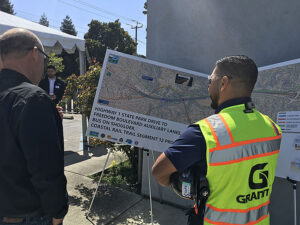By Jondi Gumz
Everyone who knows about the Highway 1 commuter traffic jam, especially in the afternoon southbound from Santa Cruz to Watsonville, tries to avoid being one of those 100,000.
Solutions have been elusive but on April 19, transportation leaders broke ground on a $100 million project they believe will break the logjam. The answer, we’re told, is “multi-modal.”
What does that mean?
It means investing in multiple strategies: Building auxiliary lanes and allowing Metro buses to bypass traffic on the shoulder — an initiative requiring legislation championed by then-Assembly member Mark Stone — building crossings over Highway 1 for people on foot and bike, and building a trail alongside the Santa Cruz Branch Rail Line.
Metro, by the way, is working on more solutions: Boosting bus ridership to 7 million by 2027 and building 224 affordable rentals at its bus stations so people could live closer to where they work.
Here are the numbers: Downtown Santa Cruz (Pacific Center North), 120 units, to break ground in late 2023, Watsonville, 60 units, requires 24 months of design and permitting, and ParaCruz project, Highway 1/Soquel Avenue, 60 units, groundbreaking in 5-7 years.
The first phase of Highway 1 focuses on 41st Avenue in Capitola to Soquel Drive, with the pedestrian-bike walkway over the freeway connecting the Santa Cruz Gardens and Emerald Bay neighborhoods near the Animal Shelter with the Sheriff’s Office, a 2-mile walk to Twin Lakes State Beach or Schwan Lake.
Target completion date is end of 2025.
Bids are being sought for the second phase, from Bay/Porter in Soquel to State Park Drive in Aptos, including an overcrossing near Mar Vista Elementary, with the possibility of construction in late summer/early fall.
For the third phase, from State Park Drive to Freedom Boulevard with four overcrossings, environmental work is underway.
Michael Tree, named Metro general manager in March, called bus on shoulder “a game-changer” in the agency’s push for buses to be seen as fast and reliable. Metro’s board committed to make buses arrive every 15 minutes, he noted.
Bus on shoulder was pioneered on freeways in San Diego, starting in 2022 for three years, using driver assistance technology.
Future Vision
Leaders of the Santa Cruz County Regional Transportation Commission, which is spearheading the project with CalTrans, are so excited about the future they ordered Freedom Bakery to create shortcake cookies topped by icing showing an uncrowded Highway 1 and a parade of people on the to-be-built overcrossing.
“It’s possibly the largest transportation project in our county,” said Supervisor Manu Koenig, who represents the area where the first overcrossing will be built.
Guy Preston, RTC executive director since 2018, was on hand, despite his foot being in a walking boot.
Sarah Christensen, RTC engineering construction manager, emceed the groundbreaking, promising this would be “the first of many celebrations.”
She said construction will begin in a few weeks on the Soquel Drive buffered bike lanes, another part of the multi-modal strategy to reduce congestion, boost safety and encourage more people to switch from cars to bikes for short trips.
2,167 Jobs
Caltrans estimates the Highway 1 project will create 2,167 jobs.
The contractor is Granite Construction of Watsonville.
Another expected benefit is a reduction in greenhouse gases from vehicle emissions, aligning with the state Climate Action Plan.
The multi-modal approach has support from the state with Matthew Yosgott, deputy director of the California Transportation Commission, recommending $107 million.
He was in attendance for the groundbreaking along with Scott Eades, named in February as director of Caltrans Region 5, which includes Santa Barbara, San Luis Obispo, Monterey, San Benito and Santa Cruz counties.
“It’s an iconic symbol, being able to move across the highway,” Eades said.
The multi-modal approach also found favor with Congress, getting $30 million in federal funds. It is one of nine in the nation to receive “mega grant” funding through the $1.2 trillion Bipartisan Infrastructure Investment and Jobs Act signed into law in November 2021.
Officials credit voters for passing Measure D, the half-cent sales tax in 2016, leveraging state and federal funds to meet transportation needs over the next 30 years.
•••
Top Photo: The April 19 groundbreaking on the Highway 1 multimodal improvements: Auxiliary lanes, bus on shoulder and freeway over-crossing.
